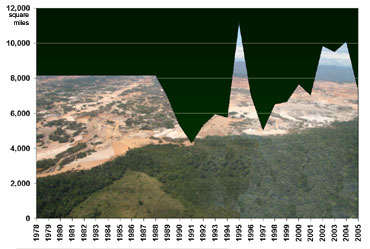Brazil closes down illegal timber operation, seizes wood
Rhett A. Butler, mongabay.com
April 11, 2006
Brazilian environmental authorities closed down an illegal logging operation in the Amazon according to a report from the Associated Press.
An agent with Ipaam, the environmental authority of Amazonas state, told Michael Astor of the Associated Press that the Norte Wood logging company was operating without a license in town of Novo Aripuana. The agency made one arrest and seized 500 cubic meters (17,655 cubic feet) of wood in the raid.
Astor notes that loggers from the neighboring state of Para have been moving into Amazonas after decimating much of their own supply in the southern part of the state. Para was the site of the Dorothy Stang slaying. Stang, an American nun who worked with rural poor, was assassinated by gunmen associated with local plantation owners. In response to the murder, the Brazilian government sent in the army to quell violence in the region and promised to step up environmental monitoring efforts.
 Deforestation Figures for Brazil, 1978-2005 |
Brazil’s environmental regulations require landowners in the region to keep 80 percent of their forested areas standing and, according to Astor, “logging is permitted in the forest reserve, but companies must file management plans to show their logging is carried out in a sustainable manner, with minimal damage to the forest.” Norte Wood’s operation had not been approved by the state.
In March, Brazilian president Luiz Inacio Lula da Silva announced a plan to allow sustainable logging across 3 percent of the Amazon rain forest. The law is aimed at undermining destructive illegal logging activities — currently responsible for most of the commercial timber extraction in the region — while generating revenue for forest management and protection, and income for rural Brazilians in the region who often must rely on subsistence agriculture or employment on ranches and plantations under sometimes slave-like conditions.
While logging has played a part in the continuing loss of rainforest in the Amazon, most recent deforestation results from agricultural expansion, especially among cattle ranchers, large-scale soybean producers, and subsistence farmers. Since the close of the 1990s, deforestation rates of primary forest cover in Brazil have climbed by 35 percent while the Amazon has lost more than 132,000 square kilometers of rainforest.
This article used quotes and information from an Associated Press article.